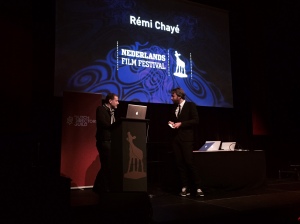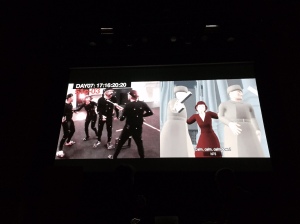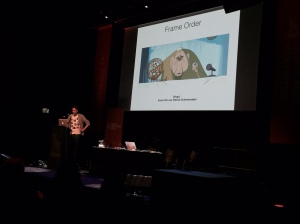 27th September, 12.15, Utrecht
27th September, 12.15, Utrecht
It’s a lazy Sunday and Utrecht welcomes the guests of the Netherlands Film Festival with a warm sun. The event is a big one: conferences and screenings are happening simultaneously, most of them related to live action film making. But luckily this particular Sunday is related to animation too, with a seminar Animatieregie or, for non-Dutch speakers like myself, Animation Direction seminar.
The first guest is a French director, Rémi Chayé. A little bit shy, visibly nervous for the approaching talk, Chayé goes on stage and introduces himself. Rémi Chayé is a 2D animator, graduated at La Poudrière in 2005 with the short ‘Eaux Fortes‘. He’s also the director of ‘Tout en Haute du Monde’ (in English ‘Long Way North’), an animation feature, winner of the Prize of the Public at the last edition of the festival of Annecy.
Today’s talk, explains Chayé, is about producing an animation movie. To do so, there are some basic steps you need to follow: first, write a script; then, decide the graphic style of the animation, the look and feel you want your work to communicate; then find a producer and, eventually, produce a pilot.
For him these phases took him more than eight years: after the writer Fabrice De Costil showed him the script, he started working on it, visualizing the ways in which the story could be told; in 2008 he found a producer, in 2011 created the pilot, and finally in 2015 the movie was released.
Producing an animation, as Chayé testifies, is long and patient work. But the most important thing is the work in the pre-production phase, concentrating mostly on the animatic. The animatic determines everything: the shots, the colors, the development of the story. The directing part, he says, ends with the animatic. But the other fundamental function of this tool is to show a potential producer what you’ve got in mind. When you’re looking for money (and you have to ‘belly dance’ for the financiers, as he describes it), you have to be sure of what you want to do in the movie — or at least you have to look like you are, says Chayé. And animatics of course can help you in this process.
The second speaker of the day is Karsten Kiilerich, from Denmark. His speech starts with the presentation of his last movie ‘Albert‘, a 3D animation movie he directed. For Kiilerich, everything depends on the pitch, how you present your work to someone else. By pitching, he says, you’re more able to clarify your own ideas, in order to explain it to a potential producer. At first, he continues, there are always the gatekeepers, those who ask you stupid questions. At that moment the most important thing is to know how to sell yourself: by showing confidence, you’ve got more chances to be taken seriously. Just like Chayé, Kiilerich points out that the most important thing when presenting a project is the animatic, the movie before the movie. Even if the process of producing a 3D animation is quite different from 2D animation, the animatic follows the same logic. The only difference, he explains, is that while the characters are 2D, the set is 3D.
The Dutch speakers are up next, starting with Belgian director Jan Bultheel.
 He talks about the atypical animation feature he just finished, with the title ‘Cafard‘, a hybrid of principes of live action – working with live actors – and animation – fantastical landscapes and imagination. He did not use a storyboard, but trusted the actors. Bultheel describes it as the opposite of fiction: the actors play without a camera, and you work out the camera positions afterwards. Bultheel is critical of blockbuster films like ‘TinTin’, that according to him suffers from bad acting. He feels the slick visuals are unfairly prioritized. Instead, in ‘Cafard’ he really trusted the actors to carry the film.
He talks about the atypical animation feature he just finished, with the title ‘Cafard‘, a hybrid of principes of live action – working with live actors – and animation – fantastical landscapes and imagination. He did not use a storyboard, but trusted the actors. Bultheel describes it as the opposite of fiction: the actors play without a camera, and you work out the camera positions afterwards. Bultheel is critical of blockbuster films like ‘TinTin’, that according to him suffers from bad acting. He feels the slick visuals are unfairly prioritized. Instead, in ‘Cafard’ he really trusted the actors to carry the film.
Hans Walther shows behind the scenes material of a couple of series he has been directing; ‘De Sprookjesboom’ for the Efteling and ‘Café de Wereld’ for the Dutch program ‘De Wereld Draait Door’. He mentions that directing for him is really about keeping a crew of people enthusiastic and motivated.
 This is also confirmed by the next speaker, Joost Lieuwma. Besides showing his hilarious new short ‘Paniek!’, he talks about his approach to directing. For him this is about team work. In his studio Frame Order they all work together and provide feedback on each others work. Because it can be difficult to keep a fresh look when making 34 versions of the storyboard, he has a test audience look at it, or flips the storyboard.
This is also confirmed by the next speaker, Joost Lieuwma. Besides showing his hilarious new short ‘Paniek!’, he talks about his approach to directing. For him this is about team work. In his studio Frame Order they all work together and provide feedback on each others work. Because it can be difficult to keep a fresh look when making 34 versions of the storyboard, he has a test audience look at it, or flips the storyboard.
Mascha Halberstad of course has to tell the story about how she was approached by The Prodigy to make a music video (apparently one of the band members was flicking though channels and stumbled upon Nederland 3 which showed her film ‘Munya in Mij’). But mainly she discusses her work on ‘Munya in Mij‘, a stop motion project. She didn’t use a storyboard in this case; she wanted to be able to make decisions standing in front of the set, looking for a casual feeling.
Nice anecdote: Halberstad used lube to make tears, which an assistant had buy at a sex shop. Feeling embarrassed, she said at the counter: “It’s not for me, it’s for a film…”
Erik van Schaaik, last but not least, shows the making of of his newest film ‘The Apple Tree’. He stresses that directing is managing a team: the quality of your team is the quality of your animation. In the past he worked with people without enough skills, and had to redo parts of a film, or spend a lot of time on explaining what he wanted. This time he worked with very skilled people. He feels he got the most out of the challenging shots, since that made people really creative in finding solutions.
All the directors give precious advice to all who are interested in animation. The experiences that are shared in the presentations show that there are as many ways to approach directing as there are people. But although quite a few of the people present don’t rely on a storyboard, the importance of preparation is stressed often. You need to be smart at the beginning, in order to be efficient and not have unwanted surprises at the end. And to do so, it’s best to start as soon as you can.
Report by Federica d’Urzo & Sarah Lugthart
Pictures by Esther Schmidt